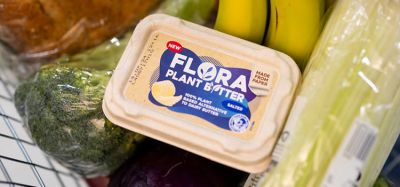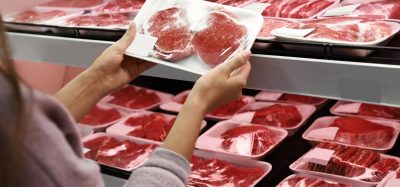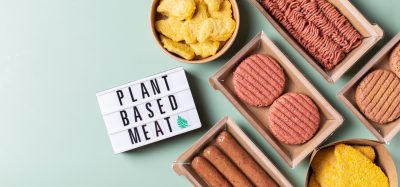The challenge of clean label reformulation
- Like
- Digg
- Del
- Tumblr
- VKontakte
- Buffer
- Love This
- Odnoklassniki
- Meneame
- Blogger
- Amazon
- Yahoo Mail
- Gmail
- AOL
- Newsvine
- HackerNews
- Evernote
- MySpace
- Mail.ru
- Viadeo
- Line
- Comments
- Yummly
- SMS
- Viber
- Telegram
- Subscribe
- Skype
- Facebook Messenger
- Kakao
- LiveJournal
- Yammer
- Edgar
- Fintel
- Mix
- Instapaper
- Copy Link
Posted: 22 February 2010 | Holly Hughes, Charles Speirs & Sarah Chapman, Campden BRI | No comments yet
With consumers becoming more aware of what is in their diet, there is a growing interest in more ‘natural’ and healthy foods free from additives. The UK food industry is under increased pressure to simplify ingredient lists and remove ‘artificial’ additives from foods. The increasing popularity of the clean label movement within the EU is shown through data obtained by Mintel’s Global New Products Database (GNPD). Between January 2008 and June 2009, the most popular claim made when launching new food and beverages was ‘no additives’ or ‘no preservatives’. This was found on 13,441 products1. In addition, 23 per cent of global food and drinks launches in 2008 featured ‘natural’ or ‘no artificial….’ claims2.
When discussing clean label, the difference between the terms ‘clean label’ and ‘natural’ needs to be defined3. Within the UK, the Food Standards Agency recently reviewed its guidance on the use of the term ‘Natural’ with regards to the labelling of foods. Although clean label is a term that is being widely used in the industry, there is no legal definition and therefore a lack of consistency between stakeholders regarding what constitutes clean label. For example, ingredients acceptable to one retailer may not be acceptable to another, with confusion between what constitutes a ‘kitchen cupboard guarantee’ and ‘clean label’4.
To assist manufacturers in the development of clean label products, research at Campden BRI is investigating alternatives to some common additives. Currently, research on emulsifiers and natural colours is being undertaken, whilst information on recent research into functional native starches is available.
Emulsifiers
Emulsifiers are needed to stabilise emulsions or products where one immiscible phase is dispersed through a second immiscible phase. The food and beverage industry relies on an annual supply of some 300,000 tonnes of emulsifier to produce the wide range of common foodstuffs that consumers enjoy, with the main application being bakery products5.
Most of the emulsifiers produced are mono and diglycerides and their derivatives, which constitute approximately 70 per cent of total production. This group alone is responsible for 26 E-numbers in Europe.
It is not straightforward to eliminate emulsifiers or replace them with clean label alternatives in complex food and drink systems. The consequence of the removal of emulsifiers is that it would no longer be technically feasible to produce many products on an industrial scale. For example, anyone who has tried to make a simple French dressing with olive oil and vinegar knows that the oil in water dispersion is only stable for a very short time. Without using emulsifiers, it would not be possible to achieve a commercially viable process and product.
Alternative polysaccharide-based emulsifiers such as gum arabic or pectin are classified as additives and not ingredients. This again raises the question of degree of cleanliness of the label. There may be occasions where a label declaration of ‘pectin’ is preferred even though this is strictly speaking not clean label, as it is recognised by consumers from use in home-made jam. Protein based materials such as soy, lupin and pea, and lipid based materials from oats are known to have emulsification properties. Lecithin, extracted from egg or soy, is documented as the first commercial emulsifier6. Again, such materials would attract label declarations, but such declarations could be viewed as softer than a claim of (e.g.) mono and diglycerides and their derivatives.
One route to a clean label declaration could be the inclusion of a foodstuff which includes an active component. Emulsifying properties have been attributed to the two major cell wall components of yeast: mannoproteins and beta glucans. These two materials can constitute over 90 per cent of the yeast cell wall, which could lead to the clean label declaration of ‘yeast’. The processing of yeast to produce functional materials could be a route to clean label. When yeast is stressed by exposure to saline solutions, it produces glycerol7. Subsequent use of this yeast in bulk fermentation of dough might eliminate the need for emulsifier addition in bakery items.
The use of enzymes seems, potentially, to be a straightforward route to attain a clean label declaration. If enzymes are added to a food formulation and are subsequently denatured during processing, they can be classified as processing aids and do not attract a label declaration. According to trade literature, enzymes are widely used in bakery applications and in some cases, they are promoted by the suppliers as a route to a clean label.
The fact that the emulsifier supply industry is dominated by mono and diglycerides and their derivatives is indicative that these materials are cost effective in use. Any alternative clean or cleaner label material may not be cost competitive and would therefore be more likely to deliver benefits in a niche or high value product area.
Colours
A recent UK Food Standard Agency (FSA) study was carried out by the University of Southampton to determine the effect of certain artificial colours (tartrazine, quinoline yellow, sunset yellow, carmoisine, ponceau 4R, allura red) and benzoate on hyperactivity in children8. Subsequent to this study, the European Parliament adopted new labelling regulations for foods containing any of these food colours; they must be labelled with the words “may have an adverse effect on activity and attention in children.” More recently, the European Food Safety Authority (EFSA) advised lowering the Acceptable Daily Intake of three of the colours: quinoline yellow, sunset yellow and ponceau 4R9. This may mean that levels allowed in foodstuffs, or the range of foodstuffs in which they are permitted, will be reduced.
There are four main classes of plant pigment: chlorophylls, carotenoids, flavanoids and betalains, which account for the majority of naturally derived colours (Table 1). All added colours must be declared on a food product in the EU, where there is no legal distinction between artificial and natural food colours. However, food manufacturers are keen to use colours derived from naturally occurring pigments, or colouring foodstuffs.
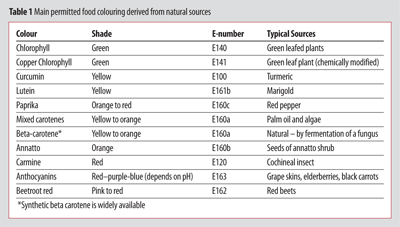

The term ‘colouring foodstuffs’ refers to products that contribute colour, but are food ingredients not colour additives. According to the FSA Food Additives Legislation guidance notes,10 colouring foodstuffs must not have been selectively extracted during their preparation or they would be considered a food colour and fall under these regulations. Colouring foodstuffs will therefore impart colour, flavour and nutritive components to the food and their usage rate is generally higher than comparable additive colour. Examples of colouring foodstuffs include fruit and vegetable juice concentrates such as elderberry (red), spinach (green) and pumpkin. As food regulations vary around the world, legislation on colours should be consulted for each world market where the product will be sold. It may be necessary in some cases to have a different colour system in products sold in different areas.
Many factors need to be considered when choosing a natural colour or colouring foodstuff. These include the food matrix, recipe, acidity, processing, packaging, legislation and price. The type of food into which the colour is incorporated will affect the choice of colour. Colour manufacturers have worked on improving water dispersible forms of naturally oil soluble pigments such as carotene. Some examples of these colour emulsions produce a colour ring formation in the bottleneck of soft drinks. For fat based foods, naturally water soluble colour pigments can also be formed into stable emulsions which ensure even dispersion. Some ingredients can enhance colour stability whereas others will destabilise a colour. For example, metal ions present from hard water sources or used to fortify a food and beverage can destabilise some colours.
The pH of a product may have a significant effect on both the stability and the shade of some colour pigments; the most well known example is anthocyanins, which change from a red/pink colour at low pH to a more purple/blue colour as the pH increases. The severity of heat processing that a food product receives also has a large effect on stability, as heat labile colours will fade or brown on heating. Generally, the higher the temperature and the longer the time of heat processing, the greater the effect on the colour and the more restricted the choice of colours becomes. Finally, the type of packaging used is important as some colours are sensitive to oxygen and light. Many colour pigments will fade or brown over time when exposed to light.
Functional native starches
Although the techniques used to produce functional native starches are not new, the industry has only become aware of these ingredients in the past few years. Because of industrial demand, new physically modified starches have been developed with similar process tolerances to chemically modified starches, but which can be labelled simply as ‘starch’. These functional native starches are now becoming more available for a wide range of applications, including the replacement of additives such as thickeners and stabilisers in food products.
Campden BRI has completed research into clean label starches and their use as thickeners in soups and sauces. This research compared the performance of physically modified (PM), native (N) and chemically modified (CM) starches for use as cook-up starches in sauces11,12,13,14. A high fat cheese sauce, low pH tomato sauce and a high sugar toffee sauce were developed to show the behaviour of starches in various food environments. Rapid Visco Analysis (RVA) and Differential Scanning Calorimetery (DSC) were used to evaluate the behaviour of the starches in solution and in sauces. Freeze-thaw trials were performed on starches in solution and in the three different sauces. Sensory and rheological analysis was carried out to compare eight toffee sauces with the objective of determining the effect of the type of starch and level on the sensory characteristics.
Physically modified starches had to be used at higher concentrations than the chemically modified starches to give a similar final viscosity in solution11. In the three sauces, RVA profiles demonstrated that even when used at concentrations that gave similar viscosity in solution, the starches gave different final viscosities in the sauces. This is believed to be linked to the type and level of modification, with one of the physically modified starches following closely the behaviour of the chemically modified starch while the other followed that of the native starch12.
Freeze-thaw research indicated that under controlled frozen conditions with little temperature fluctuation, the physically modified waxy maize starch and native waxy rice starch investigated provided acceptable stability in a high fat or high sugar sauce. The tomato sauce trials showed that the high acid environment caused all the starches to become unstable and retrograde to varying degrees. This limited stability indicated that the acidic environment is the most challenging for food manufacturers13.
Sensory trials carried out during this research concluded that with the toffee sauce investigated, the change in the starch type and level significantly affected the perceived thickness, gelatinous texture and flavour attributes. It also demonstrated the importance of adjusting the concentration of the starch used to replace a chemically modified starch, to give a similar final viscosity to ensure minimal changes to the sensory texture and appearance attributes14.
These studies demonstrated the functional capability of alternative ‘clean label’ starches available to replace chemically modified starches in food and drink products. Physically modified and some native starches can offer process stability such as freeze-thaw stability similar to chemically modified starches, if used at the correct concentration level. It is important for manufacturers to understand the different properties of replacement starches to be able to successfully replace chemically modified starches in existing products.
Conclusion
With the high demand from retailers and consumers for the reduction in the use of additives in foods, manufacturers are having to find new clean label ingredients and improved production methods to produce quality food products. New clean label ingredients are being developed for use in various food products to meet this industrial demand. There are many issues surrounding the replacement of additives from the legal aspects of new ingredients, to issues of product stability and safety during shelf-life. In many cases, direct replacements for synthetic additives cannot be found, with product reformulations, process method developments and quality issues needing to be investigated in all products. With the complex and wide-ranging product development issues surrounding clean label recipe development, expert guidance and independent research on the subject will be invaluable to industry. Campden BRI can offer such assistance.
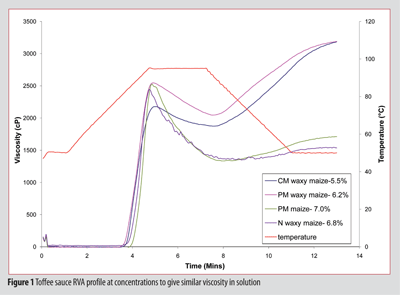

References
- Heller, L. (2009) Post-market food review highlights EU consumer priorities. http://www.foodnavigator.com/ Financial-Industry/Post-market-food- review-highlights-EU-consumer-priorities. Accessed 26/11/09.
- Watson, E. (2009) It’s only natural. Food Manufacture, March 2009, 39-40, 43.
- Alldrick, A.J (2009) The clean label concept. New Food Digital, Issue 2, 4-6, 8-9. http://www.newfoodmagazine.com/
- Watson, E (2006) The big label clean-up causes problems for manufacturers. http://www.foodmanufacture.co.uk/news/ fullstory.php/aid/3153/The_big_label_clean-up_causes_problems_for_manufacturers.html. Accessed 27/11/09.
- Moonen, H. and Bas, H. (2004) Mono- and diglycerides. In Emulsifiers in Food Technology. Ed. by R.J. Whitehurst. Blackwell Publishing Ltd. UK.
- Whitehurst, R.J. (2004) Emulsifiers in Food Technology (Ed) Blackwell Publishing Ltd UK
- Lien-Te Yeh, Charles, A.L., Chi-Tang Ho and Tzou-Chi Huang (2009) A novel bread making process using salt-stressed baker’s yeast. Journal of Food Science. http://www3.interscience.wiley.com/journal/122610047/abstract?CRETRY=1&SRETRY=0
- McCann, D., Barrett, A., Cooper, A., Crumpler, D., Dalen, L., Grimshaw, K., Kitchin, E., Lok, K., Porteous, L., Prince, E., Sonuga-Barke, E., Warner, J.O., and Stevenson, J. (2007) Food additives and hyperactive behaviour in 3-year-old and 8/9-year-old children in the community: a randomised, double- blinded, placebo-controlled trial. Lancet 370 1560-1567.
- FSA, (2009) European Food Safety Authority issues opinions on six artificial colours. News centre, 12 November 2009. http://www.food.gov.uk/news/newsarchive/ 2009/nov/efsaopinion
- Food Standards Agency (2002) Food Additives Legislation Guidance Notes.
- Hughes, H., Chapman, S., Hooper, G., Sahi, S. (2006) The performance and characterisation of native, physically modified and chemically modified maize starch. Campden BRI. R&D Report No. 229.
- Hughes, H., Chapman, S., Hooper, G., Sahi, S. (2007a) Performance and characterisation of ‘clean label’ starches in sauces. Campden BRI. R&D Report No. 242
- Hughes, H., Chapman, S., Sahi, S. (2007b) Freeze-thaw properties of different starches in aqueous solutions and sauces. Campden BRI. R&D Report No. 248.
- Chapman, S., Gilbert, C., Hughes, H., Pfeiffer, J., Sahi, S. (2008) Sensory assessment and rheology measurement of toffee sauces made with modified and ‘clean label’ starches. Campden BRI. R&D Report No. 252.



